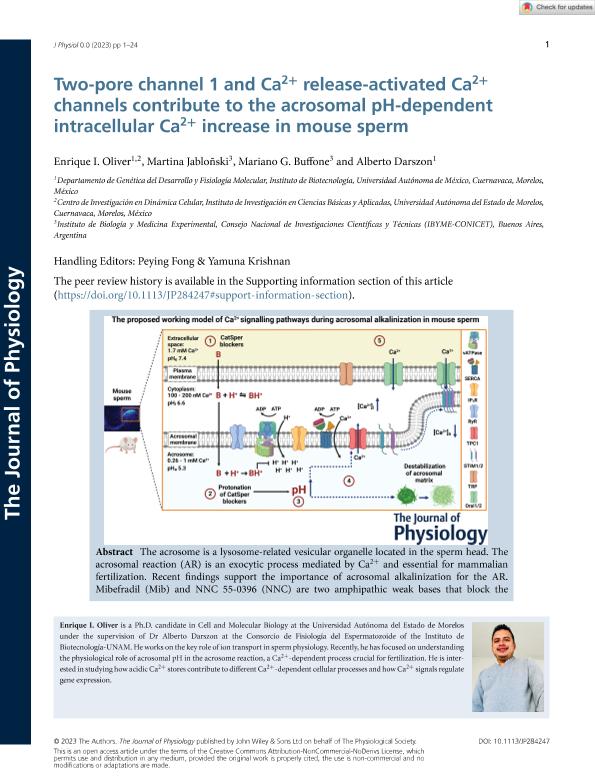Artículo
Two-pore channel 1 and Ca2+ release-activated Ca2+ channels contribute to the acrosomal pH-dependent intracellular Ca2+ increase in mouse sperm
Fecha de publicación:
2023
Editorial:
John Wiley and Sons Inc
Revista:
Journal of Physiology
ISSN:
0022-3751
e-ISSN:
1469-7793
Idioma:
Inglés
Tipo de recurso:
Artículo publicado
Clasificación temática:
Resumen
The acrosome is a lysosome-related vesicular organelle located in the sperm head. The acrosomal reaction (AR) is an exocytic process mediated by Ca2+ and essential for mammalian fertilization. Recent findings support the importance of acrosomal alkalinization for the AR. Mibefradil (Mib) and NNC 55-0396 (NNC) are two amphipathic weak bases that block the sperm-specific Ca2+ channel (CatSper) and induce acrosomal pH (pHa ) increase by accumulating in the acrosomal lumen of mammalian sperm. This accumulation and pHa elevation increase the intracellular Ca2+ concentration ([Ca2+ ]i ) and trigger the AR by unknown mechanisms of Ca2+ transport. Here, we investigated the pathways associated with the pHa increase-induced Ca2+ signals using mouse sperm as a model. To address these questions, we used single-cell Ca2+ imaging, the lysosomotropic agent Gly-Phe-β-naphthylamide (GPN) and pharmacological tools. Our findings show that Mib and NNC increase pHa and release acrosomal Ca2+ without compromising acrosomal membrane integrity. Our GPN results indicate that the osmotic component does not significantly contribute to acrosomal Ca2+ release caused by pHa rise. Inhibition of two-pore channel 1 (TPC1) channels reduced the [Ca2+ ]i increase stimulated by acrosomal alkalinization. In addition, blockage of Ca2+ release-activated Ca2+ (CRAC) channels diminished Ca2+ uptake triggered by pHa alkalinization. Finally, our findings contribute to understanding how pHa controls acrosomal Ca2+ efflux and extracellular Ca2+ entry during AR in mouse sperm. KEY POINTS: The acrosomal vesicle is a lysosome-related organelle located in the sperm head. The acrosome reaction (AR) is a highly regulated exocytic process mediated by Ca2+ , which is essential for fertilization. However, the molecular identity of Ca2+ transporters involved in the AR and their mechanisms to regulate Ca2+ fluxes are not fully understood. In mammalian sperm, acrosomal alkalinization induces intracellular Ca2+ concentration ([Ca2+ ]i ) increase and triggers the AR by unknown molecular mechanisms of Ca2+ transport. In this study, we explored the molecular mechanisms underlying Ca2+ signals caused by acrosomal alkalinization using mouse sperm as a model. TPC1 and CRAC channels contribute to [Ca2+ ]i elevation during acrosomal alkalinization. Our findings expand our understanding of how the acrosomal pH participates in the physiological induction of the AR.
Archivos asociados
Licencia
Identificadores
Colecciones
Articulos(IBYME)
Articulos de INST.DE BIOLOGIA Y MEDICINA EXPERIMENTAL (I)
Articulos de INST.DE BIOLOGIA Y MEDICINA EXPERIMENTAL (I)
Citación
Oliver, Enrique I.; Jabloñski, Martina; Buffone, Mariano Gabriel; Darszon, Alberto; Two-pore channel 1 and Ca2+ release-activated Ca2+ channels contribute to the acrosomal pH-dependent intracellular Ca2+ increase in mouse sperm; John Wiley and Sons Inc; Journal of Physiology; 601; 14; 2023; 1-24
Compartir
Altmétricas




